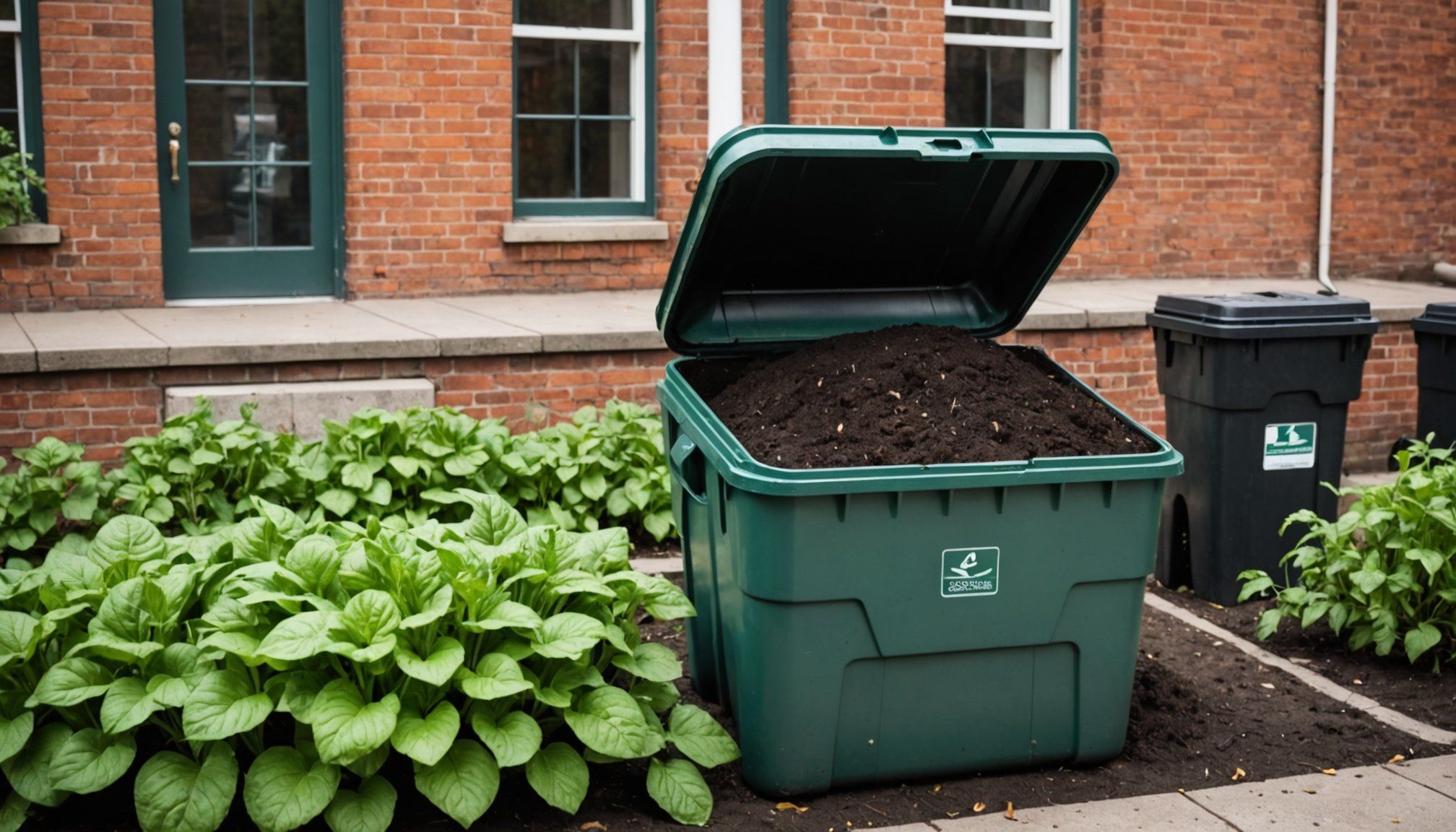Understanding Odorless Composting
Odorless composting is revolutionising kitchen waste management efforts by offering a fresh, scent-free option, ideally suited for urban environments. By channelling these waste materials into a structured composting system, households contribute significantly to an environmentally-friendly cycle, thereby harnessing the benefits of composting for both the environment and their living spaces.
The benefits of composting extend well beyond waste management, positively impacting soil health by enriching it with nutrients. In urban areas, where living spaces are confined, controlling odour is paramount. Odorless composting ensures that individuals residing in city apartments can perform kitchen waste management without unpleasant smells disrupting their living environment.
Have you seen this : Unlock Hidden Storage: Must-Know Tips to Maximize Space in Your Home
The key to effective composting in small spaces lies in understanding and implementing the principles of adequate aeration, maintaining the right moisture levels, and ensuring balance between green and brown materials. This meticulous process not only controls odours but also accelerates the composting process, making it suitable for various urban living scenarios ranging from apartments to shared living spaces. Successful composting in these settings encourages more households to compost, even in limited spaces, and facilitates broader social and environmental benefits. By managing kitchen waste responsibly, urban composters significantly reduce landfill additions.
Choosing the Right Composting System
Selecting the right composting system for an urban dwelling involves considering various apartment composting solutions. Different compost bins cater to specific needs and preferences.
Have you seen this : Transform Your Home into a Cozy Haven: Top Tips for This Year
Types of Odorless Composting Systems
-
Worm composting (vermicomposting) involves using worms to break down organic waste, making it ideal for apartment use. Worms are efficient and create high-quality compost.
-
Bokashi composting uses beneficial microorganisms to ferment kitchen waste. This method is compact, fast, and works well in small spaces, though it requires the use of special Bokashi mix.
-
Electric composters offer a modern twist, rapidly breaking down waste with minimal effort. They’re great for individuals seeking fast, low-maintenance solutions but can be more costly.
Factors to Consider When Selecting a System
- Space availability: Ensure the composting unit fits your living space.
- Cost-effectiveness: Compare initial and ongoing costs across different systems.
- Suitability for kitchen waste types: Not all systems handle all kinds of waste equally; understand which system best matches your waste type needs.
Composting systems enhance urban living by managing kitchen waste efficiently, enriching your home environment without intruding on it.
Step-by-Step Guide to Composting Kitchen Waste
Composting kitchen waste efficiently hinges on understanding core composting techniques. It begins with preparing waste, where proper separation is essential. Avoid adding meat, dairy, or oils, which can disrupt the composting process and attract pests. Instead, focus on plant-based kitchen composting steps like cutting larger pieces into smaller bits for faster decomposition.
Layering is a crucial method to prevent unpleasant odors. Begin with a base layer of dry materials, such as shredded paper or dried leaves, and alternate with wet organic waste like vegetable peels. This balance maintains appropriate moisture levels and aeration, which are vital in composting methods.
Monitoring moisture levels is another key step. Compost should feel like a damp sponge. Too dry, and decomposition slows; too wet, and odors can develop. Adjust the mix by adding dry materials or moistening with water as necessary. Regularly aerate the compost by turning it with a pitchfork or shovel every couple of weeks. This act introduces oxygen, promoting microbial activity and hastening the composting techniques process.
Keep an eye on the temperature within your compost pile. An active pile should be warm to the touch, indicating internal heating from the breakdown of materials, ensuring effective composting.
Troubleshooting Common Composting Issues
Successfully maintaining a compost system requires addressing potential issues proactively. Often, one of the primary concerns is odor problems, which can significantly deter urban composters. An imbalance in carbon and nitrogen materials can lead to offensive smells. To eliminate odors, check your compost’s balance: if it leans too much on kitchen scraps, add more brown materials like newspaper or dried leaves. Additionally, increase aeration by regularly turning the pile to incorporate oxygen and reduce anaerobic bacteria, which contribute to the smells.
Identifying Signs of Odor Problems
Unpleasant odors are a telltale sign of a problem within your compost. Solutions include ensuring proper ventilation and adjusting moisture levels. If your compost feels too wet, add dry matter, and for overly dry piles, introduce a small amount of water to achieve a balance akin to a damp sponge.
Other Common Composting Challenges
Various challenges accompany compost maintenance. Pests, such as fruit flies, often find their way into compost bins. Implement wire mesh or ensure tight-fitting lids to prevent access. Additionally, if decomposition seems slow, consider supplementing your compost with green materials rich in nitrogen, such as fresh grass clippings. This aids in maintaining a warm, active compost pile for efficient breakdown.
Benefits of Odorless Composting for Urban Dwellers
Odorless composting presents an innovative solution for urban residents, enhancing both home and communal environments. The composting benefits extend beyond waste reduction, playing a vital role in urban gardening by providing nutrient-rich compost for plant growth. This enriches community green spaces, transforming them into lush, productive areas and supporting biodiversity even in densely populated regions.
A significant benefit of odorless composting is its contribution to food waste reduction. It allows city dwellers to actively participate in sustainable living by transforming kitchen scraps into valuable compost, thereby minimising landfill contribution and reducing methane emissions. This environmentally-friendly approach fosters a cycle of renewal and resource conservation—a small yet impactful step towards a more sustainable city.
Urban residents experience additional advantages such as improved property value and aesthetics when composting benefits translate into healthier gardens and vibrant landscapes. Community engagement flourishes as residents connect over shared environmental goals, fostering a sense of pride and cooperation. As city dwellers adopt odorless composting practices, they not only enhance their spaces but also contribute positively to the broader ecological system, shaping a cleaner and greener future for all.
Maintaining Your Compost System
Regular compost maintenance is vital for a thriving, odorless composting system. Proper upkeep ensures efficient decomposition and avoids common issues. Regularly turning and aerating your compost is crucial. This action introduces oxygen and helps prevent anaerobic conditions, which can cause unpleasant smells and slow decomposition. Aim to turn your compost every two weeks to maintain adequate airflow and microbial activity.
Monitoring temperature is another important aspect. An effective compost pile should feel warm to the touch, indicating active breakdown of materials. Temperature drops may suggest the need for more nitrogen-rich materials or increased aeration. Similarly, keeping an eye on moisture levels is essential. Compost should resemble a damp sponge; too dry, and the process stalls, while excess moisture might lead to odors. Adjust the mix by adding water or dry materials as required.
Embrace best practices for ongoing care: ensure a balanced mix of brown and green materials, and avoid adding meat, dairy, or oils. Implement these strategies diligently, and your compost will serve as an effective solution to kitchen waste management while providing nutrient-rich soil for urban gardening needs. Through consistent compost care, you can enjoy the full array of composting benefits.
Expert Insights and Additional Resources
It’s beneficial to seek composting tips from seasoned experts when embarking on your composting journey. Expert composting advice often starts with maintaining the balance necessary for an effective compost pile. Environmentalists stress the importance of balancing green and brown materials to control odors and accelerate decomposition. As one expert notes, “Achieving the right balance ensures that your compost system works efficiently without any unpleasant surprises.”
Incorporating practical advice, experienced composters emphasize the regular monitoring of your compost pile to keep it optimally moist and aerated. Attuning your composting methods to local climate conditions can further enhance results.
Quotes and Tips from Composting Experts
- “Regularly turn your compost to keep it active and prevent foul odors.”
- “Adapt your composting techniques based on seasonal changes to optimise efficiency.”
Further Reading and Resources
Broadening your knowledge through reputable sources can deepen your understanding of composting. Explore books and articles that delve into specific composting techniques and methods. Participating in local composting workshops or community programs provides hands-on experience and fosters connections with other composters. These resources bolster your composting efforts, equipping you with the knowledge required for successful and sustainable urban composting.











